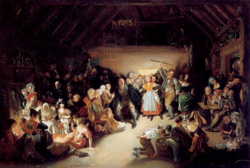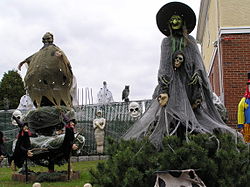Halloween
Halloween is a celebration on the night of October 31. It is most practiced in the United States, Australia and Canada. Children wear costumes and go to people's homes saying "Trick or treat!" to ask for candy (sweets in the UK) and people give it to them. People traditionally dress up as ghosts, witches, or other scary things for Halloween.[1]
For Christians it is the eve of All Saints' Day, which begins the three-day observance of Allhallowtide. This covers the three days – October 31 (All-Hallows Eve or Halloween), November 1 (All Saints) and November 2 (All Souls). All Hallows' is a Christianized holiday and originated in Ireland. It also has pagan roots.[2][3]
Origins
Halloween originated from Ireland. The pagan holiday Samhain, which the All Saints holy day replaced, was also known as the Day of the Dead. Many wiccans and modern pagans celebrate the Day of the Dead. It is the day that some believed the souls of dead people come back to Earth. This is a happy holiday (even though it celebrates death) because some of the souls will visit the homes of their family. Pope Gregory III originally designated Halloween on November 1 as a time to honor all saints. Soon, All Saints Day incorporated some of the traditions of Samhain.[4]
Many Lutheran churches celebrate a holiday on November 2 called the Reformation. This holiday celebrates the day that Martin Luther put The Ninety-Five Theses on a church door.
After mass Irish and Scottish immigration in the 19th century, Halloween became a major holiday in America.
The pagan rituals of earlier times evolved into fun and games. For example, the concept of connecting to the dead was replaced with the more lighthearted idea of telling the future. Bobbing for apples became popular as a fortune-telling game on All Hallows' Eve: Apples would be selected to represent a woman's suitors, and the apple she ended up biting into would supposedly represent her future husband. Halloween posed a huge matchmaking opportunity for young women in the 19th century.[5]
Symbols
Development of symbols connected with Halloween formed with time. Jack-o'-lanterns are traditionally carried on All Hallows' Eve in order to scare evil spirits. Elements of the fall season, such as pumpkins, harvest, and scarecrows, are also common. Homes are often decorated with these types of symbols around Halloween. Halloween imagery includes themes of horror, magic and the supernatural. Black and orange are Halloween's traditional colors.
Costumes
During Halloween, some people, especially children, wear costumes. People have worn costumes at Halloween for centuries. Wearing a costume may come from Celtic festivals of Samhain and Calan Gaeaf. It could also be from the Christian Allhallowtide.
Early costumes were usually scary. They were often supernatural beings or from folklore. In the 1930s costumes of characters from literature, radio, or movies became popular, and such costumes are also popular today. Scary costumes are still popular.
On social media Halloween costumes are less scary and more focused on aesthetic appeal. People often draw inspiration from movie characters and other sources for their Halloween costumes.[6]
Games and Other Activities
In addition to trick-or-treating, there are several traditional activities connected with Halloween.
- In old times people would try to tell the future, especially to try to learn who they would marry.
- People make Jack-o-lanterns and place them in front of their houses.
- People play a game called apple bobbing. In this game apples are placed in water, and people must try to remove the apples with only their teeth.
- Telling ghost stories, listening to Halloween-themed songs and watching horror films are common activities on Halloween. TV shows (with special shows usually for children) are commonly shown on or before Halloween, and new scary films are often released before Halloween.
- Visiting a 'haunted attraction'. These are places like houses, farms, or forests, which are decorated in a scary way, and where actors in costumes make scenes to scare the visitors.
- Decorating one's house and front yard. People will often decorate the front part of their houses with Halloween-themed symbols like ghosts, graves, and black and orange objects.
Halloween Media
An early 20th-century Irish Halloween mask displayed at the Museum of Country Life in County Mayo, Ireland
Snap-Apple Night, or All-Hallow Eve, painted by Daniel Maclise in 1833, shows people feasting and playing divination games on Halloween in Ireland.
A plaster cast of a traditional Irish Halloween turnip (swede, rutabaga) lantern on display in the Museum of Country Life, Ireland
"Halloween Days", article from American newspaper, The Sunday Oregonian, 1916
Decorated house in Weatherly, Pennsylvania
At Halloween, yards, public spaces, and some houses may be decorated with traditionally macabre symbols including skeletons, ghosts, cobwebs, headstones, and witches.
"Halloween" (1785) by Scottish poet Robert Burns, recounts various legends of the holiday.
An automobile trunk at a trunk-or-treat event at St. John Lutheran Church and Early Learning Center in Darien, Illinois
Humorous display window in Historic 25th Street, Ogden, Utah
References
- ↑ "How To Remove Halloween Makeup Easily". Beverly Hills MD. October 28, 2021. Archived from the original on October 26, 2022. Retrieved November 16, 2021.
- ↑ Rogers, Nicholas (2003). Halloween: From Pagan Ritual to Party Night. Oxford University Press. p. 22. ISBN 978-0-19-516896-9.
- ↑ "These Halloween traditions all have Irish origins". October 31, 2021.
- ↑ "Halloween 2021".
- ↑ Donovan, Blair; Gold, Marissa (October 27, 2021). "What's the Real History of Halloween—and Why Do We Celebrate It on October 31?". Country Living. Retrieved November 16, 2021.
- ↑ Jezer-Morton, Kathryn (October 26, 2024). "Why Isn't Halloween Scary Anymore?". The Cut. Retrieved October 27, 2024.












